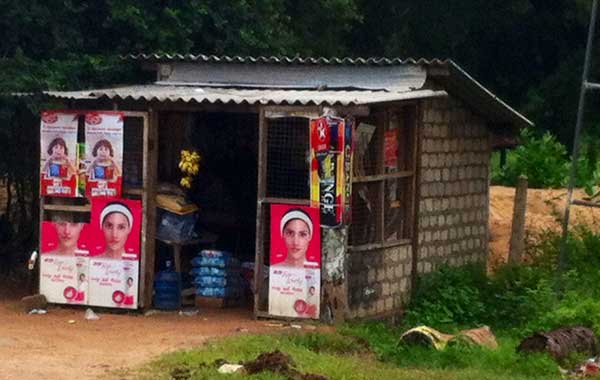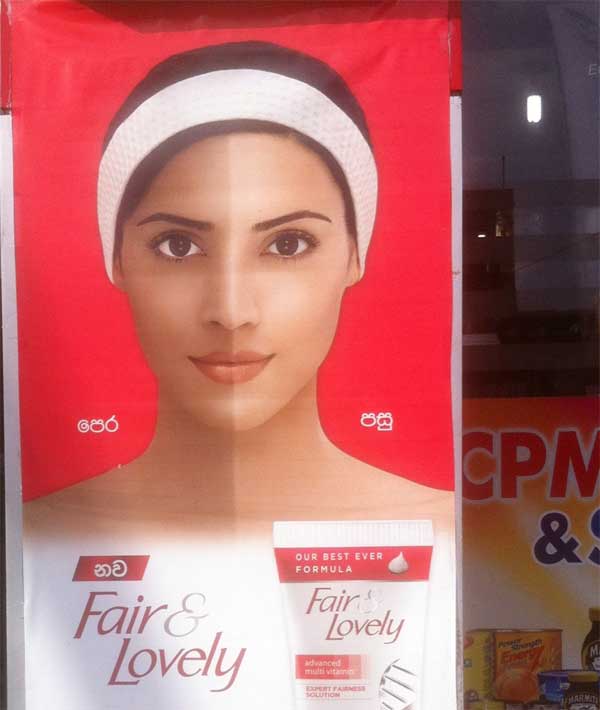On the road from Kilinochchi a ramshackle roadside kiosk advertises the skin-whitening product Fair and Lovely. Kilinochchi was the de facto capital of the unofficial Tamil Eelam state until 2009. Until the recent presidential poll the young beauty’s bifurcated face competed with now deposed Mahinda Rajapaksa’s for curbside predominance. He presided during the campaign over a kind of verge majority that proved just as phantasmagoric.
Most of Sri Lanka’s subsistence farms and modest homes front the street with such kiosks. They range from thatched palm shacks displaying corn, coconut and curd, to rendered stalls gaily painted lime green, mandarin orange, turquoise blue or cinnamon yellow and stocked with fizzy drinks, ‘short eats’ (snacks) and coloured tubs.
But on the road north of Kilinochchi the kiosks were more likely to stock the essentials of scooter, trishaw and bicycle parts. Behind were bullet-pocked homes, about a quarter still lying in ruins. In Jaffna amputees get on with their lives, men’s truncated legs swinging beneath their sarongs, young women standing on bus stops, their sleeves neatly sutured over stumps. Out in the fields the palm trees were punched through with mortar fire. Tall, blackened palms stand decapitated. Wandering the roads are cows caged only in ribs and mangy rain-stung dogs.
Unsurprisingly the smarmy, Bollywoodesque Mahinda Rajapaksa, sporting possibly the only moustache in the land, was almost nowhere to be seen in the North. The Fair and Lovely ads reigned supreme, and held their own after the poll when Rajapaksa lay shredded on the verge – just retribution for the executive rule he refused to tear up having waged peace.

But in the south Rajapaksa’s hammy campaign bills were posted on every conceivable surface. In this region, his stronghold, he concentrated much of the Chinese investment, building an international airport in his hometown. It is said to feature a Crony Lounge, Boondoggle Bistro and a personalised getaway airstrip directed away from The Hague.
Rajapaksa may still have to answer for war crimes. He is accused of deliberately shelling civilians when ruthlessly quashing the thuggish LTTE. Some 40,000 may have died. (And despite urgings from the Pope, newly elected President Maithripala Sirisena has shown little interest in cooperating with a UN inquiry).
The 25-year conflict was fought across an ethnic dichotomy entrenched through the centuries old contract between religion and state and imported labour from Southern India. Claims to origin by Tamil and Sinhala are contested through the myth of Vijaya, an exiled 6th-century-BC North Indian prince who landed near present-day Mannar – legend has it on the day that the Buddha attained enlightenment. As a trading hub the Island was awash with migration and successive waves of colonization by the Portuguese, Dutch and British.
After independence in 1948 the United National Party (UNP)’s attempt to repatriate the many ‘Plantation Tamils’ brought in by the English from India and deny them citizenship played to Sinhalese nationalism. In 1956 the Sri Lankan Freedom Party (SLFP), brought down a Sinhala-only bill that effectively denied Tamils access to government jobs and services. A law passed in 1970 favoured Sinhalese for admission to universities. In 1981 Sinhalese (possibly including government forces) burnt down Jaffna’s library, which contained precious Tamil artifacts such as ancient palm-leaf manuscripts. It was followed in 1983 with the ‘Black July’ massacre on Tamil in Colombo.
In the postcolonial south the truth claims of ethnic difference are projected onto contested territory. As Paul James has argued, Rajapaksa pursued a neoliberal economy while invoking tradition in his clothing. This form of cultural management hardened categories of difference already entrenched through colonial administrators and processes of state formation.
The Fair and Lovely advertisements festooning the household stalls display another strategy of cultural management.
Paleness as beauty ideal in the 19th century testified to a life out of the elements, of upper-class refinement and leisure. Yet industrial labour induced a much-lamented pallor in women factory workers. Tanning became the province of the Outdoor Girl, leisured and sun-kissed. But skin-whitening products continued to target women of colour and indigenous consumers. The pale ideal intersected hierarchies of native skin with agricultural work such as tea-picking, and with interwar ideologies of white supremacy and ‘phenotypes’. The racialised politics of skin lightening recurred around the globe as consumer capitalism reached into China, India and South Africa from the 1920s.
Fair and Lovely is a Unilever brand launched in Kenya in 1993 and selling in over 40 countries. Its website proclaims it the No. 1 ‘fairness cream’. Unilever cagily claims it whitens customers with sunscreens and ‘Allotoin’, not by bleaching agents. It ‘activates the Fair and Lovely vitamin system to give radiant even toned skin’. Somehow the product manages to ‘disperse’ melanin. Their new ‘Advanced Multivitamin’ formulation ‘targets key fairness problems’ and ‘contains “white optics” which brighten the skin’.
Fair and Lovely information repeatedly links ‘dull’ to ‘dark’. The pack contains an ‘expert fairness meter’ by which to measure results. It contains Sodium Ascorbyl Phosphate, an antioxidant, Niacinamide, which can produce itching and rash and Hydroxystearic acid which can cause inflammation and is a known respiratory irritant that can cause lung damage through long-term exposure. It shouldn’t enter the blood stream or make contact with the eyes. Yet the product is not contraindicated for women with acne and is promoted as lightening dark rings under the eyes.
Specialist dermatologist Ashraf Reda, at Dubai’s Welcare Hospital, says the chemicals in skin-whitening products “damage the cells and prohibit cell regrowth, causing permanent pigmentation” that is, darkening. Fair and Lovely however claims not to contain Hydroquinone, a potential carcinogen which causes ochronosis, nor mercury, both commonly used in skin whitening products.

Skin Whitening products are popular in Asia, exceeding the $2 billion mark by 2012. All of the women in Sri Lankan advertisements are noticeably paler than the women perched on bike racks, passing beneath them. I saw one ad for weight reduction. I suspect any photoshopping on ads for bridal accessories, jewellery and fashion is instead concentrated on skin tone. News anchors, singers and celebrities likewise seem to be paler than women I met personally. In service and counter jobs paler girls and men predominate. Gardeners and manual labourers are generally darker skinned.
Skin lightening products (there is also a Fair and Handsome for men) suggests that, despite decades of independence and five years of peace, the marketplace is still structured by colour castes, colour-coding the overlapping identities Sri Lankans have to manage through daily regimens in the ‘care of self’.
Cosmetic products are implicated in the cultural management of Sri Lanka’s national ethnic formation and social hierarchies through what Franz Fanon called the epidermalization of inferiority. Whitening can only be a cozening of the epidermal economy that prevails despite independence, civil war, and now the democratic ousting of a corrupt and callous despot. Sirisena should avoid showing his face next to the Fair and Lovely bunting, bleaching ironically in the tropical sun.
Donate To New Matilda
New Matilda is a small, independent media outlet. We survive through reader contributions, and never losing a lawsuit. If you got something from this article, giving something back helps us to continue speaking truth to power. Every little bit counts.



